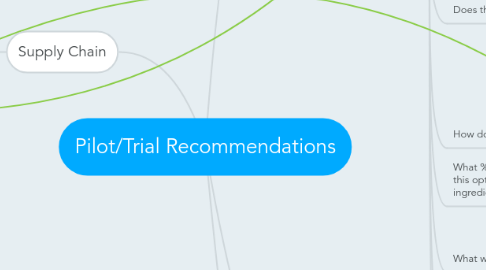
1. Supply Chain
1.1. Reactions from suppliers?
1.1.1. What kind of documentation can they provide?
1.1.2. Will they do it?
1.1.3. How deep can you go?
1.1.4. Can we reach international suppliers?
1.1.5. Does the confidential information clause affect ability to complete the process?
1.1.6. Would it be more efficient if they initiated?
2. What feedback?
2.1. Is it doable?
2.1.1. Verify that the process is achievable by the BPM
2.1.2. What are likely obstacles?
2.1.3. What will cost? $, time
2.1.4. Complex/simple products
2.1.5. Different types of companies
2.1.5.1. Large/small
2.1.5.2. Green chemistry leaders
2.1.5.3. International/domestic
2.1.5.4. How motivated?
2.1.5.5. Sector experience with supply chain programs
2.1.5.6. More or less vertical integration
2.1.6. Does the quick hazard screen work?
2.1.6.1. Does it provide useful information?
2.1.7. For commodity materials?
2.2. How difficult will it be for the auditor to certify?
2.2.1. Will be same auditor that does standard EMS, or someone else?
2.3. Enhanced achievement options
2.3.1. how feasible?
2.3.2. What % of BPMs will use?
2.3.3. Which options are being used?
2.4. What documentation vehicles is it easiest for companies to use?
2.4.1. Do they already have most recent GHS SDS?
2.4.2. Do you need alternatives options to GHS?
2.5. How much standardization of documentation do we need to do to implement the guidance?
2.5.1. Docs to auditors?
2.5.2. Docs from BPMs to project teams?
2.6. Does the process help BPM?
2.6.1. Was the assessment process actionable for positive change?
2.6.1.1. Does it help reduce risk below reg levels?
2.6.2. Was the comparative assessment helpful?
2.6.3. Does it help them see differences between suppliers?
2.6.4. Does it lead to more sales?
2.6.5. Can BPM do this with internal staff, or do they need outside consultants?
2.7. How does the BPM adapt to changes?
2.7.1. What's amendment process if suppliers change?
2.8. What % of products going through this option have flagged ingredients
2.8.1. How many tier 1 suppliers have EMS?
2.9. What was each company's starting platform?
2.9.1. Can it be done with non-ISO EMS?
2.9.1.1. What's the process?
2.9.2. How many are starting from RC?
2.9.3. How many are starting from ____?
2.10. What do companies need over/above existing EMS?
2.10.1. Do companies already have conforming Guiding Principles?
2.11. Is it a challenge to define what constitutes a "product"?
2.11.1. One vs. many within a product line?
3. What tested, by whom?
3.1. Start with components within a more complex product.
3.2. What are auditor requirements?
3.2.1. Variation in criteria developed by different auditors?
3.2.2. How will they use Guidance Doc.
3.2.3. ISO 17065-compliant auditors?
3.2.4. Who is the auditor engaging with inside the BPM?
3.2.4.1. Compliance staff?
3.2.4.2. R&D staff?
3.3. BPM/Supplier pair
3.3.1. For building envelope
3.3.2. For interior fitout
3.4. How does this play out for recycled content materials?
3.5. Are there other programs generating the same outcomes?
4. What does success look like?
4.1. More sales for BPM?
4.2. Lots of verified products
4.2.1. At least 10 BPMs go through with at least 1 product each
4.2.1.1. Complex products: 2 components would be good.
4.2.2. 4-5 certifiers participate
4.2.2.1. including non-US
4.3. Replicable process
4.3.1. Extendable to other manufacturers
4.4. Project teams awarded the point using Option 3
4.4.1. They seek out Option 3 as a desireable path.
